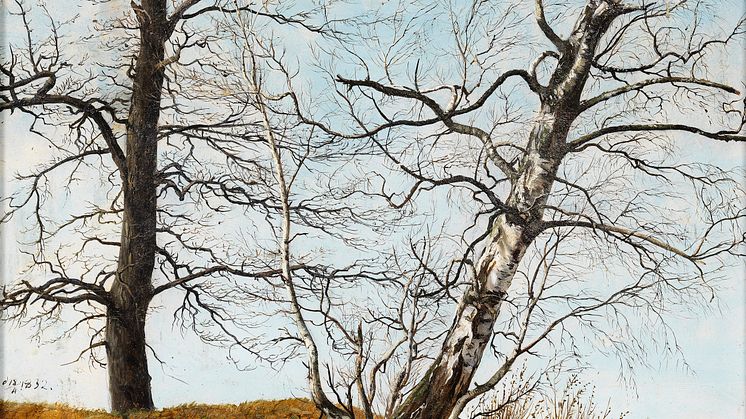
Press release -
New acquisition: Three examples of Dresden Romanticism
Nationalmuseum has acquired three works by painters of the Dresden Romantic school: Fantasy of the Alps by Carl Gustav Carus, Oak and Birch by Carl Julius von Leypold and Dresden at Sunset by Knud Baade. Along with the works by Johan Christian Dahl already in the museum’s collection, the new acquisitions constitute a comprehensive presentation of a significant period in the art history of northern Europe.
For several decades starting around the turn of the 19th century, Dresden was a major centre of the Romantic movement in literature, philosophy and art. The ideas behind this intense period of artistic creativity rippled across much of Europe. A key figure of the period was Caspar David Friedrich, who advocated a fundamental renewal of the landscape painting genre. Previous timeless and faraway landscapes from around 1800 harkened back to Claude Lorrain’s 17th-century Arcadian scenes. Caspar David Friedrich broke with this long-held ideal by painting more realistic motifs. He depicted nature with great precision and allowed the locations of his paintings to appear as if they were the audience’s own surroundings. However, his intent was to connect onlookers through the image with something else, perhaps best described as the freedom to let their own imagination take over. A relationship between artist, painting and audience that, according to some, constitutes the very essence of Romanticism as expressed by the poet Novalis in the famous lines, “The world must be romanticized. Only in that way will one rediscover its original senses. […] I romanticize something when I give the commonplace a higher meaning, the known the dignity of the unknown, and the finite the appearance of the infinite.”
Incorporating lifelike elements, Caspar David Friedrich composed his landscapes so as to turn scenery into food for the imagination rather than mere terrain, so as to remind audiences of the extraordinary that is inherent in the familiar. All three of Nationalmuseum’s new acquisitions illustrate this principle.
Carl Gustav Carus’ (1789–1869) Fantasy of the Alps is a transfixing scene with the dominant, dramatically positioned eagles in the foreground. Longing was a concept central to Romantic art and literature, and was often represented by the horizon or by distant mountains that awaken dreams of what lies beyond. The eagles in effect make this painting a Romantic manifesto, as if to prove the point that there are no limits to how far the inner eye can see. A doctor by profession, Carus was a member of Dresden’s intellectual elite and was close friends with Goethe, Caspar David Friedrich and Johan Christian Dahl.
Carl Julius von Leypold (1806–1874) studied under both Johan Christian Dahl and Caspar David Friedrich. Of all Friedrich’s pupils, he was the one who came closest to his teacher in terms of technique – so much so that several of his paintings were long mistaken for works by Friedrich and have only fairly recently been identified as Leypold’s work. Nationalmuseum’s newly acquired painting is a study of an oak and a birch tree on a hillside. Judging by the date on the work, 18 April 1832, it was painted in a single day, and the fresh style suggests that Leypold painted it on location. However, it is also conceivable that he did not find a scene that looked exactly like this, but rather sought out the trees individually after deciding what he was going to paint. Although meticulously realistic in its depiction of nature, there is something about the painting that is hard to pin down, something that feeds the audience’s imagination. The intricately stylized branches of the trees call to mind the ornamentation of Gothic cathedrals, and the hillside is balanced in such a way that it is hard not to imagine what might lie beyond.
The third painting is not much bigger than a postcard, but epic in nature. It is dated 1838. Knud Baade (1808–1879) travelled from Norway to Dresden to study under Johan Christian Dahl. During his time in the city, he also encountered Caspar David Friedrich. In this work, he painted a view of Dresden from a spot beside the Elbe just outside the city. All is quiet and the sun is setting. Examining the painting in detail, we find nothing that could truly be described as unrealistic or unnatural, and yet that is effectively how it seems. Baade may have painted the scene to take home as a souvenir. As Novalis would have said, Baade romanticized the city he was visiting and thus came to know it. He gave the finite the appearance of the infinite, and the known the dignity of the unknown.
Nationalmuseum’s purchase of these works has been made possible by a generous bequest from the Wiros Fund. Nationalmuseum has no budget of its own for new acquisitions, but relies on gifting and financial support from private funds and foundations to enhance its collections of fine art and craft.
Press contacts
Carl-Johan Olsson, Curator, carl-johan.olsson@nationalmuseum.se, +46 8 5195 4324
Hanna Tottmar, Press Officer, press@nationalmuseum.se, +46 767 234632
Categories
Nationalmuseum is Sweden’s premier museum of art and design. The collections comprise older paintings, sculpture, drawings and graphic art, and applied art and design up to the present day. The museum building is currently under renovation and scheduled to open again in 2018. In the meantime, the museum will continue its activities through collaborations both in Sweden and abroad as well as temporary exhibitions at the Royal Swedish Academy of Fine Arts, Fredsgatan 12 and Nationalmuseum Design at Kulturhuset Stadsteatern in Stockholm. Nationalmuseum has partnerships with Svenska Dagbladet and the Grand Hôtel Stockholm, and acknowledges the support of FCB Fältman & Malmén.

